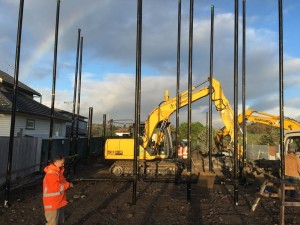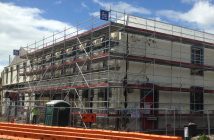At no other time in Auckland’s history has the city found itself at such a significant and defining crossroads. 
Auckland’s councillors will now determine whether to accept or reject the recommendations of the Independent Hearings Panel (IHP) on the Auckland Unitary Plan (AUP).
Once finalised and adopted, the AUP is going to be the next big step in bringing Auckland together and delivering the vision of the Auckland Plan, which is to become the world’s most liveable city by 2040.
To say that the journey to getting the AUP operative has been arduous is an understatement. It has involved Auckland’s most extensive public consultation. When the AUP was first released for public consultation, it received over 13,000 submissions, containing over 1.4 million submission points.
The subsequent IHP hearings lasted nearly two years, with members of the Panel wading through over 10,000 pieces of evidence across 60 different topics. I would like acknowledge the mammoth task the IHP was charged with and recognise the ability and expertise of the panel in developing a set of dynamic, objective and robust recommendations.
With the IHP having done its job, councillors now need to make the right decision, which is to accept the IHP’s recommendations. I am not being overly dramatic when I say the economic, environmental and social prosperity of not only Auckland, but also of the New Zealand is at stake.
If the councillors do not fully endorse the IHP’s recommendations then the strategic inertia, political infighting and lack of leadership which dogged Auckland governance prior to amalgamation is likely to resurface. Make no mistake, this cannot be allowed to happen.
So why has the AUP process been so controversial? The AUP will replace the existing Regional Policy Statement as well as 13 existing district and regional plans. Essentially the AUP will be the blueprint and rulebook that will determine where and how future commercial, industrial and residential development can take place. However, at its heart, the AUP is more than this. It is the tool to enable the accommodation of up to an additional million residents and will drive Auckland’s future form and shape.
Arguably, it is the most contentious developmental issue that Auckland has ever faced. The AUP conversation has gone well beyond the proverbial debate around the summer barbeque. It’s a debate that has pervaded wider economic, environmental and social issues facing a rapidly growing city.
New Zealand’s largest city is facing greater wealth inequity and inequality; there is an ever-widening gulf between those who can afford to own their own home and those who cannot. The effects of this equality gap is substantial and affects the delivery of local and central government economic and social policy. We need an Auckland in which people can afford to live and own their own homes in healthy, sustainable and well-functioning communities.
The IHP has recommended greater intensification of existing urban areas with a strong focus on the existing centres. It has also identified areas at the periphery of the city suitable for development. We all want our communities to be economically, environmentally and socially prosperous and to provide opportunities for people of all walks of life.
Growing up
So if we are this benevolent, then why the rigmarole? The issue for most people is not the growing out, but the growing up. What are the implications of the proposed new housing density zoning and rules for people living in Ponsonby villas? Or for people with their post-World War Two, quarter-acre section in Henderson? Or the state housing tenants in Glen Innes?
It is important to remember that despite the naysaying of the vocal NIMBYs, development does not spring up overnight. It is an organic process that can take several years. People are not going to open their curtains one morning and see bulldozers tearing down their neighbours’ homes, leaving them bereft in a sea of density if the AUP becomes operative in the form as recommended by the IHP.
I do not blame the NIMBYs for their fears of the future. Auckland will inevitably experience change. The field of urban planning is riddled with technical jargon that urban planners and lawyers thrive on. We don’t have textbooks on planning for those not skilled in the murky world of resource management.
To be told that the community and the suburb in which you have lived, developed close friendships with neighbours, raised your children or possibly worked is likely to transform radically in the near future will naturally lead to a negative emotional reaction.
Humans after all are creatures of habit who enjoy predictability and stability. Cities, on the other hand, are in a constant state of flux, development and change. Our relationship with cities is a tenuous and, in the life of a city, a short-lived one.
Will the Unitary Plan deliver the Auckland we need? We support a focus on urban growth in the inner city and along key transport routes such as arterial roads and the rail network. With our current congestion problems, it makes sense to create high-quality, high and medium-density housing along these key routes. This is currently happening in New Lynn, but we desperately need to expand this to other centres along these routes.
It is also exciting to see roads like Sandringham, Dominion and Mount Eden up-zoned for density, especially as Auckland Transport has identified these as possible light rail routes. With such a substantial investment proposed, it is important to maximise the potential patronage. Furthermore, this focus on urban growth on centres, transport nodes and corridors will go towards achieving a quality urban form.
We see it as a positive that the recommended AUP places an obligation on Auckland Council to provide sufficient land for development for the next seven years. The recommended AUP would enable development of over 400,000 dwellings across a range of housing types.
I am especially pleased that the Independent Hearings Panel based this decision on the Auckland Council Development Capacity Model, a joint venture model developed by Auckland Council and Property Council.
Enabling development of over 400,000 dwellings is a substantial increase on the 296,000 dwellings that Auckland Council enabled under the original Proposed Auckland Unitary Plan. This increase better reflects the housing needs of the forecasted population growth over the next 30 years.
We support retention of a flexible and responsive Rural Urban Boundary. In particular, we support the recommended expansion to include 30 per cent more land as well as the ability to change the boundary by private plan variation of a district plan.
Implementing the Rural Urban Boundary in a regional policy statement would prevent potential changes and adjustment. The failure of the old Auckland Regional Council to expand the old urban growth boundary is a key cause of skyrocketing land prices in Auckland.
Economics is simple: creating a scarcity of resources such as land means that demand and prices will increase. These recommended changes to the Rural Urban Boundary free up more greenfield land and allow for out-of-sequence development, which should reduce opportunities for landbanking.
Quality counts
We are pleased to see the IHP recommendation of promoting good quality residential development through assessment methods, rather than through compulsion. Auckland Council needs to work with developers of residential, industrial and commercial property in a collaborative, constructive manner.
Rules such as requiring new dwellings to achieve a minimum 6-star rating from the New Zealand Green Building Council Homestar Tool or requiring compliance with sustainable building standards are noble. However, these requirements would add further cost to the already expensive exercise of building new dwellings. These costs are then simply passed onto the purchaser, doing nothing for housing affordability. These building standard matters are better dealt with under the Building Act.
It is also important to remember that the relationship between land use planning and infrastructure, particularly that relating to transport, is inextricably linked. We cannot create economically and socially prosperous communities without well-connected, reliable and safe transport networks. With this in mind, I am pleased to see the IHP emphasise the importance of infrastructure provision in catering for growth.
I am also encouraged by the IHP’s position that infrastructure funding should not be allowed to dictate land use planning in Auckland. There needs to be a robust and unified relationship between central and local government in providing necessary transport infrastructure and services for Auckland. This partnership approach will go a long way towards achieving the positive transport outcomes for Auckland that are reflected in, and which underpin, the AUP.
The question remains, can we replicate the AUP in other cities? Are there lessons that other cities can learn from the AUP development process? Different cities have differing needs and aspirations that reflect their individual economic, environmental and social drivers. A cookie cutter approach to urban planning is not going to achieve desired outcomes or best practice.
For example, heritage buildings form a substantial part of Dunedin’s urban fabric, a reflection of the city’s former status as New Zealand’s largest city. Yet a city such as Tauranga has little or no heritage buildings. This highlights the fact that the heritage rules contained in the AUP cannot be imposed effectively on either city.
However, we can learn from the AUP development process and create best practice guidance for public consultation on a city’s district plan. Auckland Council’s single biggest failure was its inability to articulate both the macro and micro policy and strategy outcomes they wanted the AUP to achieve for the wider community.
Councils must be engaging in constant dialogue with all sectors of the community when it comes to district plans. In particular, they need to be selling the story about the proposed development and evolution of their urban centres. This approach is inclusive and is more likely to bring people with expertise, ideas and information into the development fold.
It is important to reiterate that this is the first time the IHP process has been used in New Zealand. While there have been speed bumps along the way, the process has driven by an evidence-based, objective and robust approach to planning.
It is time to throw away the neo-urbanist ideology and embrace pragmatic planning principles. We are seeing the positive flow-on effects of the IHP process already, with a similar IHP process being used in reviewing Christchurch City Council’s District Plan.
Auckland, like other rapidly growing cities faces numerous difficulties across a range of economic, environmental, political and social issues. The success of our largest city has been spectacular. It is undergoing a transformation and is becoming a truly international city.
Yet, with this success comes inevitable downsides, which have and will continue to be a drag on the city. Make no mistake, the AUP is no silver bullet. We need a multi-pronged policy approach in order to achieve greater prosperity for all Aucklanders. Yet I am optimistic that the AUP provides a line in the sand and a clear opportunity to start thinking about how we can truly create the world’s most liveable city.
Connal Townsend is the chief executive of the Property Council NZ, which represents the interests of the commercial property investment industry – including commercial, industrial, retail and property funds
Image Copyright: <a href=’http://www.123rf.com/profile_patrimonio’>patrimonio / 123RF Stock Photo</a>



